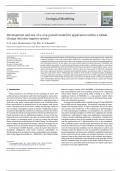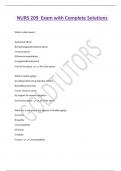Ecological Modelling 221 (2010) 314–329
Contents lists available at ScienceDirect
Ecological Modelling
journal homepage: www.elsevier.com/locate/ecolmodel
Development and test of a crop growth model for application within a Global
Change decision support system
V.I.S. Lenz-Wiedemann, C.W. Klar, K. Schneider ∗
Department of Geography, University of Cologne, Albertus-Magnus-Platz, D-50923 Cologne, Germany
a r t i c l e i n f o a b s t r a c t
Article history: When examining potential impacts of Global Change on water resources on the regional scale, spatial and
Received 28 May 2009 temporal changes in crop water and nitrogen demand are of fundamental significance. State-of-the-art
Received in revised form crop growth models are powerful tools to assess the response of crops to altered environmental conditions
18 September 2009
and cultivation practices. In this paper, the process-based, object-oriented and generic DANUBIA crop
Accepted 5 October 2009
growth model is presented. To evaluate the performance of the model, a validation analysis is carried out
Available online 16 November 2009
by comparing modelled data with various field measurements of sugar beet, spring barley, maize, winter
wheat and potato crops. Model performance statistics show that crop growth is efficiently simulated.
Keywords:
Crop growth model
The closest agreement between measured and modelled biomass and leaf area index is achieved for
Global Change sugar beet and winter wheat. Additionally, the response of the model to changed nitrogen availability
GECROS caused by cultivation practices is analysed and reveals good results. The results suggest that the model
Agro-ecosystem is a suitable tool for numerically assessing the consequences of Global Change on biomass production,
DANUBIA water and nitrogen demand, taking into account the complex interplay of water, carbon and nitrogen
fluxes in agro-ecosystems.
© 2009 Elsevier B.V. All rights reserved.
1. Introduction decision support system (DSS) DANUBIA is developed embracing
key environmental and socio-economic processes for simulating
Plants function as an interface for the exchange of water and water fluxes (Mauser and Ludwig, 2002; Ludwig et al., 2003). A
carbon between atmosphere and terrestrial biosphere. Since stom- significant feature of DANUBIA is a crop growth model which
atal control of water vapour and carbon dioxide fluxes governs the addresses the reaction of various crops to altered growing condi-
processes of transpiration and photosynthesis, vegetation plays a tions and cultivation practices.
vital role in the water, carbon and nitrogen cycle, controlling their A crop growth model within a Global Change DSS like DANUBIA
fluxes and balances in manifold ways on all temporal and spatial has to fulfil several requirements. The dynamic interplay of water,
scales. The interaction of the water, carbon and nitrogen cycles in carbon and nitrogen fluxes in agro-ecosystems has to be taken
the soil–plant–atmosphere system is further complicated in agro- into account. The model has to be responsive to meteorological
ecosystems through the interference of human activity. The choice as well as pedological conditions, to atmospheric CO2 concentra-
of crop and the specific management procedures involved have pro- tion and to managerial options. Furthermore, applying site-specific
found and large-scale eco-hydrological impacts. In view of the vast calibration is unfeasible for large-scale application. Consequently,
land surface area covered by crops, agro-ecosystems play a key role a process-based modelling approach is mandatory. Transpiration
with respect to managing water as well as carbon and nitrogen and photosynthesis have to be coupled to depict stomata reactions
fluxes, particularly in the context of Global Change. To mitigate the and the particularity of C4 photosynthesis has to be considered.
adverse effects of the projected changes, effective strategies for an Since modelled yield is an important determinant for future land
adaptive land use and water resource management are required. use plans and because of various feedback mechanisms, the influ-
In the project GLOWA-Danube, a team of experts from diverse ence of environmental conditions on the allocation of carbon and
disciplines collaborates with water resources stakeholders to nitrogen within the plant has to be accounted for. In addition, leaf
develop integrative strategies to secure sustainable water manage- area development and senescence should be modelled on the basis
ment in the Upper Danube Basin (∼80 000 km2 ). The Global Change of the interaction of leaf carbon and nitrogen dynamics. The most
relevant crops in the study area have to be included and extensi-
bility in terms of additional crops should be easily possible. Within
the DSS, modelled data for export to the other models during run-
∗ Corresponding author. Tel.: +49 221 4704331; fax: +49 221 4705124. time have to be provided and the interfaces for import and export
E-mail address: karl.schneider@uni-koeln.de (K. Schneider). parameters must be implemented.
0304-3800/$ – see front matter © 2009 Elsevier B.V. All rights reserved.
doi:10.1016/j.ecolmodel.2009.10.014
, V.I.S. Lenz-Wiedemann et al. / Ecological Modelling 221 (2010) 314–329 315
Numerous studies on the impact of Global Change on biomass Environment interaction on crop growth Simulator) is the most
production have been published (e.g. Olesen et al., 2000; recent of the Wageningen crop growth models. It is a generic model
Alexandrov et al., 2002; Wolf, 2002; Wessolek and Asseng, 2006; and incorporates the current knowledge of interacting ecophysio-
Krysanova et al., 2007) and a multitude of crop growth models logical processes. CERES (Crop Environment Resource Synthesis)
exists. Here, only a selection of those models comprising vari- comprises well established, widely used and extensively validated
ous crops can be mentioned. The DSSAT cropping system model models for different crops and is characterized by a detailed mod-
(Hoogenboom et al., 2003) includes models of 17 different crops, elling of plant processes in the rooted soil system. Within the given
among these the CERES-Maize, -Wheat and -Barley models (Jones context, the choice of this hybrid modelling approach combines
and Kiniry, 1986; Ritchie and Godwin, 2000), and was developed the advantages of the GECROS and CERES models. Because high
primarily to assess options for crop management. Over the last 20 performance computers are available and affordable and parallel
years, the DSSAT suite of models has been widely validated and computing techniques are applied, the use of a complex, state-of-
used (Jones et al., 2003). Examples for other models embracing a the-art crop growth model for large-scale applications of a DSS
set of crops are: AGROSIM (Wenkel and Mirschel, 1995), APSIM like DANUBIA is not hampered by limited computational power
(Keating et al., 2003), CropSyst (Stöckle et al., 2003) and STICS anymore.
(Brisson et al., 2003), LINTUL and SUCROS, both developed by the In order to prove the suitability of the DANUBIA crop growth
Wageningen modelling group (e.g. van Ittersum et al., 2003), as model as a tool for assessing the response of crops to Global Change,
well as the EPIC plant growth model, developed by scientists of the objectives of this study are (i) to describe the model in terms
the US Department of Agriculture (Williams et al., 1989). These are of its framework, its design, its main simulated processes, its input
all generic crop models. The EPIC model has shown its applicability data and crop-specific parameters, (ii) to provide evidence for the
particularly in the context of erosion studies. It is an integral part of capability of the model to simulate plant growth, including yield
SWAT (Arnold et al., 1998) and SWIM (Krysanova et al., 1998, 2000; formation, water and nitrogen uptake and (iii) to demonstrate the
Hesse et al., 2008). An example for integrating crop growth mod- model’s sensitivity to soil nitrogen availability. To evaluate the
els with hydrological models and remote sensing data for regional accuracy of the model, a validation analysis is carried out. Mod-
applications is PROMET-V (Schneider, 2003). elled results for various crops are compared with measurements of
Most of the models were initially not intended for use in Global biomass, leaf area index, crop nitrogen content as well as soil nitro-
Change research. Consequently, the process descriptions of plant gen and water content on the field scale. Additionally, the response
development and growth are primarily appropriate for present cli- of the model to two different fertilizer treatments is analysed. A
mate conditions. Recently, many crop models have been upgraded complete description of the model can be found in Lenz (2007).
to simulate the direct effect of atmospheric CO2 concentration on
plants. For example, in EPIC the concept of radiation use efficiency
(absorbed radiation is converted to biomass via a crop-specific fac-
tor) is extended by an empirically derived factor accounting for the 2. Model development and description
effect of CO2 . The use of, e.g. EPIC in Global Change studies is widely
accepted. However, except for specific versions of the LINTUL and 2.1. Modelling framework
SUCROS models (van Ittersum et al., 2003), the applicability of
these models for comprehensively assessing Global Change effects The DANUBIA crop growth model is one of many models
is limited, since a suitable biochemically based modelling approach included in the integrative simulation and DSS DANUBIA (Barth et
for photosynthesis is lacking. This process-based approach on the al., 2004). Within DANUBIA, models describing natural science pro-
leaf scale is necessary to comprehensively simulate the effect of cesses of, e.g. hydrology, glaciology and plant growth interact with
CO2 on plant growth. Models for gas exchange based on the bio- socio-economic models representing the decisions of actors from
chemical approach by Farquhar et al. (1980) are published, e.g. sectors such as tourism, agro-economy and water supply (see, e.g.
by Friend (1995) and Humphries and Long (1995). This biochemi- Barthel et al., 2008). The DANUBIA crop growth model simulates
cal approach is widely employed in studies of natural ecosystems the water, carbon and nitrogen fluxes within crops as well as the
(e.g. Falge, 1997; Friend et al., 1997; White et al., 1999; Reichstein, energy balance at leaf level. Its main import data are (i) meteoro-
2001; Garcia-Quijano and Barros, 2005; Lucht et al., 2006). Wang logical drivers, (ii) soil data and (iii) farming practices. The main
et al. (2005) modified the BIOME-BGC (BioGeochemical Cycles, e.g. export data are (i) agricultural yield, (ii) soil layer-specific root
White et al., 2000) model to account for winter wheat and maize characteristics, (iii) soil layer-specific water and nitrogen uptake
crops, presenting a study for the North China Plain. However, to rates, (iv) canopy characteristics such as leaf temperatures, leaf
our knowledge only two models which are applicable for several area and canopy height, (v) phenological development stage and
crops include the biochemical approach of modelling photosynthe- (vi) amounts of crop carbon and nitrogen recirculated to soil.
sis: ecosys (Grant, 2001) and GECROS (Yin and van Laar, 2005). In In DANUBIA, the soil compartment is considered to be composed
contrast to the other models mentioned above, these two models of a user-defined number of horizontal layers, assuming homoge-
use the “functional balance” theory (Brouwer, 1962) for the allo- neous characteristics within each soil layer. Each layer is described
cation of carbon and nitrogen, which is also one prerequisite for by a set of constant soil characteristics (e.g. thickness, soil tex-
comprehensively modelling the effects of Global Change. ture) and dynamic attributes like temperature, root length density,
Additional requirements set by the research objective of devel- water and nitrogen content. In this study, three soil layers (30 cm
oping a plant growth model applicable under Global Change each) are considered. For a detailed description of the DANUBIA
conditions and reactive to management options are (i) the com- soil hydrology and nitrogen model (SOIL-SNT), see Klar et al. (2008).
putational efficiency of the model to enable large-scale spatially Information on farming practices are provided by an agro-economic
distributed modelling and (ii) the provision of expandable inter- model. In turn, the agricultural yield is simulated and exported by
faces to other natural science models (hydrology, meteorology, soil, the crop growth model to determine future agricultural land use
etc.) as well as to actor models (particularly farming actors). plans (see Apfelbeck et al., 2007). The modelled phenological devel-
To fulfil the requirements listed above, the DANUBIA crop opment stage is used for adapting dates of management activities.
growth model was developed by combining and extending the DANUBIA is raster-based and suitable for modelling large water-
models GECROS (Yin and van Laar, 2005) and CERES (Jones and sheds. The spatial resolution of each grid cell is typically 1 km2 but
Kiniry, 1986; Ritchie and Godwin, 2000). GECROS (Genotype-by- can be adjusted for smaller watersheds.
, 316 V.I.S. Lenz-Wiedemann et al. / Ecological Modelling 221 (2010) 314–329
Fig. 1. The inheritance hierarchy of the class Plant as used in the DANUBIA crop growth model (Lenz, 2007), illustrated using the Unified Modeling Language (UML) (Booch
et al., 1999). Arrows pointing from the subclasses to the superclass indicate the inheritance (“is child of”) relation.
2.2. Design of the model this Plant object or are delegated to further specialized objects for
complex functionalities, which are organized in packages (collec-
The DANUBIA crop growth model is object-oriented and imple- tions of related classes). In one of these packages (leafGasExchange)
mented in Java. General plant attributes (e.g. leaf area index) and the calculations of the photosynthesis and transpiration rates at the
operations (e.g. calculation of transpiration) are implemented or leaf level are implemented. Included are the superclasses LeafGas-
declared in the superclass (parent class) Plant, being the superclass Flux as well as the subclasses LeafGasFluxC3 and LeafGasFluxC4, on
at the highest level of hierarchy for all kinds of plants. A special- account of the differences in modelling C3 and C4 photosynthesis.
ization into subclasses (child classes), representing specific crops, The package phenology comprises the functionalities for simulat-
is derived from the inheritance hierarchy as illustrated in Fig. 1. ing the phenological development of crops and is depicted in more
Crop is the superclass for all crops, providing the additional oper- detail in Fig. 2. The phenological phases (subclasses of the class
ations “sowing” and “harvesting”. Specification into the various Phase) are connected by defined conditions of transition. An object
crops is based on their assignment to a functional group (e.g. C3 Phase consists of a phase- as well as crop-specific implementation
or C4 photosynthesis type, long-day or short-day plant) and a set of for calculating phenological development and an assigned consec-
crop-specific parameters (e.g. phenological parameters). The model utive phase. Crops are categorized into three different classes in
includes the process-based growth simulation of winter wheat terms of their photoperiod sensitivity and are grouped in spring
(Triticum L.), spring barley (Hordeum vulgare), maize (Zea mays), and winter crops depending on their vernalization requirement.
sugar beet (Beta vulgaris) and potato (Solanum tuberosum). The
generic model design enables the integration of additional crops 2.3. Modelled crop growth processes
without difficulty.
At the sowing date, an object of the type Plant is generated. All The processes that are dynamically modelled by the DANUBIA
processes of crop development and growth are either calculated by crop growth model are: phenological development, photosynthe-
Fig. 2. The structure of the phenology model as used in the DANUBIA crop growth model (Lenz, 2007), illustrated using the Unified Modeling Language (UML) (Booch et al.,
1999). The depicted classes of phenological development can be further refined.








